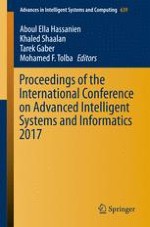2018 | Buch
Proceedings of the International Conference on Advanced Intelligent Systems and Informatics 2017
herausgegeben von: Prof. Aboul Ella Hassanien, Khaled Shaalan, Tarek Gaber, Mohamed F. Tolba
Verlag: Springer International Publishing
Buchreihe : Advances in Intelligent Systems and Computing
